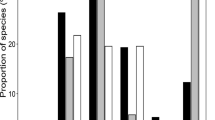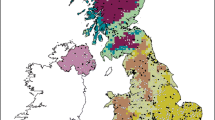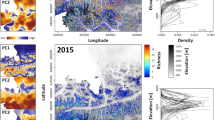Abstract
With climatic warming is the expectation of coincident changes in distributions and range limits driven by population changes. An outstanding question is whether such coincident changes (positive or negative) occur, especially in smaller regions in which management for change tends to be conducted. Using atlas and survey monitoring data (BMS) we studied population and distribution changes in 31 butterfly species in North West England over three recording periods (1940–1994, 1995–2001, 2001–2007). We found that since the first recording period many more species have shifted their centres of gravity significantly northwards and uphill than have increased in population abundance (density) and distribution cover. At the same time, far fewer species have effectively shifted southwards and downhill than have decreased in density and distribution cover. A significant association between change in distribution cover and density is divorced from the weaker association between shifts in altitude and northing; whereas many species are gaining northwards and at higher altitude, they are doing so from a failing base at lower altitude and at the core of their distributions. Usually losses at lower altitudes are ascribed to loss of biotopes. But, declines in some species, such as Lasiommata megera, are occurring at a much faster rate than physical changes to the landscape and in land uses. The findings of this study indicate that changes in populations, distributions and ranges are a great deal more complex than hitherto considered. Currently, the basis for such rapid changes is not being supported by detailed autecology on species.






Similar content being viewed by others
References
Asher J, Warren M, Fox R, Harding P, Jeffcoate G, Jeffcoate S (2001) The Millennium Atlas of Butterflies in Britain and Ireland. Oxford University Press, Oxford
Botham MS, Brereton TM, Middlebrook I, Cruickshanks KL, Roy DB (2008) United Kingdom butterfly monitoring scheme report for 2007. CEH, Wallingford
Candolfi MP, Bakker F, Canez V, Miles M, Neumann C, Pilling E, Primiani M, Romijn K, Schmuck R, Storck-Weyhermuller S, Ufer A, Waltersdorfer A (1999) Chemosphere 39:1357–1370
Cowley MJR, Thomas CD, Roy DB, Wilson RJ, León-Cortés JL, Gutiérrez D, Bulman CR, Quinn RM, Moss D, Gaston KJ (2001) Density-distribution relationships in British butterflies. I. The effect of mobility and spatial scale. J Anim Ecol 70:410–425
Dapporto L, Dennis RLH (2013) The generalist–specialist continuum: testing predictions for distribution and trends in British butterflies. Biol Conserv 157:229–236
Dennis RLH (1977) The British butterflies. Their origin and establishment. EW Callsey Ltd, Faringdon
Dennis RLH (1987) Hilltopping as a mate-location strategy in a Mediterranean population of Lasiommata megera (L.) (Lep., Satyridae). Nota Lepid 10:65–70
Dennis RLH (1993) Butterflies and climate change. Manchester University Press, Manchester
Dennis RLH (2010) A resource-based habitat view for conservation. Butterflies in the British Landscape. Wiley-Blackwell, Oxford
Dennis RLH, Bramley MJ (1985) The influence of man and climate on dispersion patterns within a population of adult Lasiommata megera (L.) (Satyridae) at Brereton Heath. Cheshire. Nota Lepid 8:309–324
Dennis RLH, Shreeve TG (1997) Diversity of butterfly species on British islands: ecological influences underlying the roles of area, isolation and faunal source. Biol J Linn Soc 60:257–275
Dennis RLH, Hardy PB (2001) Loss rates of butterfly species with urban development. A test of atlas data and sampling artefacts at a fine scale. Biodivers Conserv 10:1831–1837
Dennis RLH, Sparks TH, Hardy PB (1999) Bias in butterfly distribution maps: the effects of sampling effort. J Insect Conserv 3:33–42
Dennis RLH, Shreeve TG, Van Dyck H (2003) Towards a resource-based concept for habitat: a butterfly biology viewpoint. Oikos 102:417–426
Dennis RLH, Hodgson JG, Grenyer R, Shreeve TG, Roy DB (2004) Host plants and butterfly biology. Do host plant strategies drive butterfly status? Ecol Entomol 29:12–26
Dennis RLH, Shreeve TG, Arnold HR, Roy DB (2005) Does diet breadth control herbivorous insect range size? Predictions and tests using butterflies. J Insect Conserv 9:187–200
Dennis RLH, Dennis MP, Hardy PB, Kinder PM (2011) Range extension in butterflies: dispersal capacity, colonization potential and geographical outliers in the distribution of Aphantopus hyperantus (Linnaeus, 1758) (Lepidoptera: Nymphalidae, Satyrinae). Entom Gaz 62:83–87
Dennis RLH, Dapporto L, Dover JW, Shreeve TG (2013) Corridors and barriers in biodiversity conservation: new perspectives from the resource-based habitat viewpoint for butterflies. Biodivers Conserv. doi:10.1007/s10531-013-0540-2
Devictor V, van Swaay C, Brereton T, Brotons L, Chamberlain D, Heliölä J, Herrando S, Julliard R, Kuussaari M, Lindström Å, Reif J, Roy DB, Schweiger O, Settele J, Stefanescu C, Van Strien A, Van Turnhout C, Vermouzek Z, WallisDeVries M, Wynhoff I, Jiguet F (2012) Differences in the climatic debts of birds and butterflies at a continental scale. Nature Clim Change 2:121–124
Fox R, Dennis RLH (2010) Winter survival of Vanessa atalanta (Linnaeus, 1758) (Lepidoptera: Nymphalidae): A new resident butterfly for Britain and Ireland? Entom Gaz 61:94–103
Franco AMA, Hill JK, Kitschke C, Collingham YC, Roy DB, Fox R, Huntley B, Thomas CD (2006) Impacts of climate warming and habitat loss on extinctions at species’ low-latitude range boundaries. Glob Change Biol 12:1545–1553
Gaston KJ (1994) Rarity. Chapman & Hall, London
Hansen J, Sato M, Ruedy R (2012) Perception of climate change. Proc Natl Acad Sci 109(37):E2415–E2423. doi:10.1073/pnas.1205276109
Hanski IA, Gilpin ME (1997) Metapopulation biology. Ecology, genetics, and evolution. Academic Press, London
Hardy PB, Dennis RLH (1999) The impact of urban development on butterflies within a city region. Biodivers Conserv 8:1261–1279
Hardy PB, Hind SH, Dennis RLH (1993) Range extension and distribution-infilling among selected butterfly species in north-west England. Evidence for inter-habitat movements. Entom Gaz 44:247–255
Hardy PB, Kinder PM, Sparks TH, Dennis RLH (2010) Elevation and habitats: the potential of sites at different altitudes to provide refuges for phytophagous insects during climatic fluctuations. J Insect Conserv 14:297–303. doi:10.1007/s10841-009-9251-0
Hill JK, Thomas CD, Huntley B (1999) Climate and habitat availability determine 20th century changes in a butterfly’s range margin. Proc R Soc Lond B 266:1197–1206
Hill JK, Collingham YC, Thomas CD, Balkeley DS, Fox R, Moss D, Huntley B (2001) Impacts of landscape structure on butterfly range expansion. Ecol Lett 4:313–321
Hill JK, Thomas CD, Fox R, Telfer MG, Willis SG, Asher J, Huntley B (2002) Responses of butterflies to twentieth century climate warming: implications for future ranges. Proc R Soc Lond B 269:2163–2171
Hodgson JG, Tallowin J, Dennis RLH, Thompson K, Poschlod P, Dhanoa MS, Charles M, Jones G, Wilson P, Band SR, Bogaard A, Palmer C, Carter G, Hynd A (2014) Reasons for the failure of English agri-environment schemes: a globally-relevant lesson? Funct Ecol. doi:10.1111/1365-2435.12253
Hughes L (2000) Biological consequences of global warming: is the signal already apparent? TREE 15:56–61
Huntley B, Berry PM, Cramer W, McDonald AP (1995) Modelling present and potential future ranges of some European higher plants using climate response surfaces. J Biogeogr 22:967–1001
Huntley B, Collingham YC, Willis SG, Green RE (2008) Potential impacts of climatic change on European breeding birds. PLoS One 3(1):e1439. doi:10.1371/journal.pone.0001439
Huntley B, Barnard P, Altwegg R, Chambers L, Coetzee BWT, Gibson L, Hockey PAR, Hole DG, Midgley GF, Underhill LG, Willis SG (2010) Beyond bioclimatic envelopes: dynamic species’ range and abundance modelling in the context of climatic change. Ecography 33:621–626
IPCC (2007) Climate Change 2007: synthesis report. Contribution of working groups I, II and III to the fourth assessment report of the intergovernmental panel on climate change. Core writing team, Pachauri RK, Reisinger A (eds). IPCC, Geneva, Switzerland, p 104
Jackson ST, Sax DV (2010) Balancing biodiversity in a changing environment: extinction debt, immigration credit and species turnover. TREE 25:153–160
Jenkins GJ, Perry MC, Prior MJ (2008) The climate of the United Kingdom and recent trends. Met Office Hadley Centre, Exeter
Jiguet F, Devictor V, Ottvall R, Van Turnhout C, Van der Jeugd H, Lindström Å (2010) Bird population trends are linearly affected by climate change along species thermal ranges. Proc R Soc B Lond 277:3601–3608. doi:10.1098/rspb.2010.0796
Johnson RM, Ellis MD, Mullin CA, Frazier M (2010) Pesticides and honey bee toxicity—USA. Apidologie 41:312–331
La Sorte FA, Thompson FR III (2007) Poleward shifts in winter ranges of North American birds. Ecology 88:1803–1812. doi:10.1890/06-1072.1
Maes D, Titeux N, Hortal J, Anselin A, Decleer K, De Knijf G, Fichefet V, Luoto M (2010) Predicted insect diversity declines under climate change in an already impoverished region. J Insect Conserv 14:485–498
Mantyka-Pringle CS, Martin TG, Rhodes JR (2012) Interactions between climate and habitat loss effects on biodiversity: a systematic review and meta-analysis. Glob Change Biol 18:1239–1252
Moran MD (2003) Arguments for rejecting the sequential Bonferroni in ecological studies. Oikos 100:403–405
Parmesan C (1996) Climate and species’ range. Nature 382:765–766
Parmesan C (2006) Ecological and evolutionary responses to recent climate change. Annu Rev Ecol Evol Syst 37:637–696. doi:10.1146/annurev.ecolsys.37.091305.110100
Parmesan C, Yohe G (2003) A globally coherent fingerprint of climate change impacts across natural systems. Nature 421:37–42. doi:10.1038/nature01286
Parmesan C, Ryrholm N, Stefanescu C, Hill JK, Thomas CD, Descimon H, Huntley B, Kaila L, Kullberg J, Tammaru T, Tennent WJ, Thomas JA, Warren M (1999) Poleward shifts in geographical ranges of butterfly species associated with regional warming. Nature 399:579–583
Parry ML, Canziani OF, Palutikof JP, van der Linden PJ, Hanson CE (eds) (2007) Climate change 2007: impacts, adaptation and vulnerability. Contribution of working group II to the fourth assessment report of the intergovernmental panel on climate change. Cambridge University Press, Cambridge
Pimm SL (2008) Biodiversity: climate change or habitat loss—which will kill more species? Curr Biol 18:R117–R119
Pohorecka K, Skubida P, Miszczak A, Semkiw P, Sikorski P, Zagibajlo K, Teper D, Koltowski Z, Skubida M, Zdanska D, Bober A (2012) Residues of neonicotinoid insecticides in bee collected plant materials from oilseed rape crops and their effect on bee colonies. J Agric Sci 56:115–134
Roy DB, Rothery P, Moss D, Pollard E, Thomas JA (2001) Butterfly numbers and weather: predicting historical trends in abundance and the future effects of climate change. J Anim Ecol 70:201–217
Shreeve TG, Dennis RLH, Moss D, Roy DB (2001) An ecological classification of British butterflies: ecological attributes and biotope occupancy. J Insect Conserv 5:145–161
Sillett TS, Holmes RT, Sherry TW (2000) Impacts of a global climate cycle on population dynamics of a migratory songbird. Science 288:2040–2042. doi:10.1126/science.288.5473.2040
Sterk G, Heuts F, Merck N, Bock J (2001) Sensitivity of non-target arthropods and beneficial fungal Species to chemical and biological plant protection Products: results of laboratory and semifield trials. In: 1st international symposium on biological control of arthropods, p 306–313
Thomas JA (2005) Monitoring change in the abundance and distribution of insects using butterflies and other indicator groups. Phil Trans R Soc B 360:339–357
Thomas CD, Lennon JJ (1999) Birds extend their ranges northwards. Nature 399:213
Travis JMJ (2003) Climate change and habitat destruction: a deadly anthropogenic cocktail. Proc R Soc Lond B 270:467–473
Van Dyck H, van Strien AJ, Maes D, van Swaay CAM (2009) Declines in common, widespread butterflies in a landscape under intense human use. Conserv Biol 23:957–965
Warren MS, Hill JK, Thomas JA, Asher J, Fox R, Huntley B, Roy DB, Telfer MG, Jeffcoate S, Harding P, Jeffcoate G, Willis SG, Greatorex-Davies JN, Moss D, Thomas CD (2001) Rapid responses of British butterflies to opposing forces of climate and habitat change. Nature 414:65–69
Wickman P-O (1988) Dynamics of mate searching behaviour in a hilltopping butterfly Lasiommata megera (L.). The effects of weather and male density. Zool J Linn Soc 93:357–377
Wilson RJ, Gutierrez D, Gutierrez J, Martínez D, Agudo R, Monserrat VJ (2005) Changes to the elevational limits and extent of species ranges associated with climate change. Ecol Lett 8:1138–1146
Zuckerberg B, Woods AM, Porter WF (2009) Poleward shifts in breeding bird distributions in New York state. Glob Change Biol 15:1866–1883. doi:10.1111/j.1365-2486.2009.01878.x
Acknowledgments
We thank three referees for their suggestions and the Associate Editor Peter White for his helpful direction in revising the paper. THS acknowledges the support of the Technische Universität München—Institute for Advanced Study, funded by the German Excellence Initiative. We thank Barry T. Shaw and Laura Sivell (regional recorders for the BNM atlas) for provision of atlas data for Cheshire and Lancashire and the many participants who have kindly sent in records to the these regional databases and for Greater Manchester as part of BNM atlas records; our thanks, too, to Phillip M. Kinder for independently checking tabulations of the data and to Leonardo Dapporto for providing an inset map of the UK.
Author information
Authors and Affiliations
Corresponding author
Additional information
Communicated by Peter J. T. White.
Rights and permissions
About this article
Cite this article
Hardy, P.B., Sparks, T.H. & Dennis, R.L.H. The impact of climatic change on butterfly geography: does climatic change produce coincident trends in populations, distributions and ranges?. Biodivers Conserv 23, 855–876 (2014). https://doi.org/10.1007/s10531-014-0637-2
Received:
Revised:
Accepted:
Published:
Issue Date:
DOI: https://doi.org/10.1007/s10531-014-0637-2




